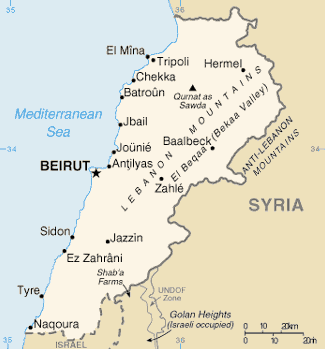Energy in Lebanon

Location
Primary energy use in 2009 in Lebanon was 77 TWh and 18 TWh per million persons.[1] Primary energy use in Lebanon was 61 TWh and 15 TWh/million persons in 2008.[2] Lebanon imports most of its energy.
As of August 2016, electricity generation capacity in Lebanon still does not meet the country's demand. Lebanon is also importing electricity from Syria. Domestic electricity is delivered at 230V 50Hz.
Overview
| Capita | Prim. energy | Production | Import | Electricity | CO2-emission | |
|---|---|---|---|---|---|---|
| Million | TWh | TWh | TWh | TWh | Mt | |
| 2004 | 3.54 | 63 | 3 | 60 | 8.85 | 15.29 |
| 2007 | 4.10 | 46 | 2 | 46 | 8.97 | 11.35 |
| 2008 | 4.14 | 61 | 2 | 61 | 9.51 | 15.23 |
| 2009 | 4.22 | 77 | 2 | 78 | 13.14 | 19.33 |
| Change 2004-2009 | 19% | 23% | -26 % | 29% | 48% | 26% |
| Mtoe = 11.63 TWh, Prim. energy includes energy losses. | ||||||
Gas
The Arab Gas Pipeline is a natural gas pipeline exporting Egyptian natural gas to Jordan, Syria and Lebanon, with a separate line to Israel.
Renewable energy
The Lebanese government intends to meet 12 percent target of its total energy needs from renewable energy sources by 2020.[4]
See also
| Wikimedia Commons has media related to Lebanon. |
References
- ↑ IEA Key energy statistics 2011 Archived 2011-10-27 at the Wayback Machine. Page: Country specific indicator numbers from page 48
- ↑ IEA Key energy statistics 2010 Archived 2010-10-11 at the Wayback Machine. Page: Country specific indicator numbers from page 48
- ↑ IEA Key World Energy Statistics 2011, Archived 2011-10-27 at the Wayback Machine. 2010, Archived 2010-10-11 at the Wayback Machine. 2009, Archived 2013-10-07 at the Wayback Machine. 2006 Archived 2009-10-12 at the Wayback Machine. IEA October, crude oil p.11, coal p. 13 gas p. 15
- ↑ Daily Star article on geothermal energy in Lebanon
This article is issued from
Wikipedia.
The text is licensed under Creative Commons - Attribution - Sharealike.
Additional terms may apply for the media files.